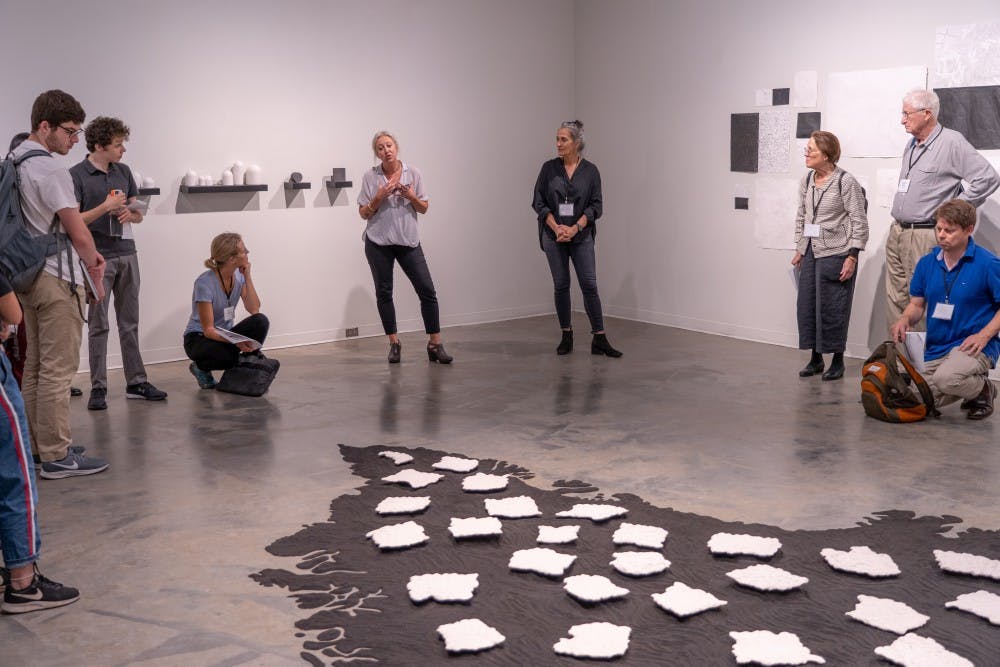“We are not scientists,” explained activist artists Yvonne Love and Gabrielle Russamongo when giving a talk on their latest work, currently on display in Ruffin Gallery. “Our entrance into this work was visual.” The pair of collaborating artists may not be climate scientists, but Russamongo’s photography and Love’s material-based sculptures tell a story of climate change that numbers and data cannot. Their work, titled “A Quick and Tragic Thaw,” was made possible thanks to the research of Environmental Science Professor Howard Epstein. Love and Russamongo have weaven a story through that data and materialized myriad climate maps, data, trends and migration patterns into an intimate and emotional installation.
The work consists of a central piece surrounded by four complementary pieces hanging on the wall, leaving the room in Ruffin Gallery surrounded by a story of tragic climate violence. The floor piece is a Greenland-shaped sea of black sand, amongst which float numerous, small porcelain icebergs. On one wall is an array of printed satellite photographs, and, on top, nails and silk string shape out the melted area of Greenland’s Jakobshavn glacier. “We extract [the] shapes we think are beautiful,” explained Russamongo.
Another wall features digital maps printed on recycled plastic that has been heated and deformed. “Melting happened as a result of the material,” Love said while explaining the process behind its creation. The maps depicts humanity’s many effects on a once-pristine environment, including oil fields, shipping routes and migration patterns of species forced by climate change. The medium of melted plastic makes for an ironic statement, while giving its contained data an aesthetic and stylized presentation.
The wall opposite the satellite photographs features pin-pierced drawings and carbon paper arranged to depict a story of its own. A topographical outline resembles a bird, ironically contrasted against trends and data highlighting climate change’s disastrous effects and habitat destruction for birds. Love discussed the “big, long, rich history of maps as storytelling items,” and the artists’ intentions were clear when the individual maps and trends came together to suggest a bigger picture. The work effectively contrasts the effects of the Anthropocene on the natural world that existed in its place.
Completing the installation is the final wall — a line of graphite ingots rendering everything from more maps to the Inuit words for Ice. The array of ingots and their diverse content reflect the multimodal effort that made Love and Russomongo’s work with “A Quick and Tragic Thaw” possible. All of the installations combined map data and scientific observations with simple, essential materials that are accessible and affordable. Russomongno mentioned how the low costs of the physical materials necessary left more budget for the story that would be told with the data hosted on those materials. “So much of how you get something installed is what form it comes in,” added Love, suggesting an artistic preference to keep medium minimal in service of a purer message.
The artists also wanted to ensure their work was in service of an emotional meditation free of politics. Consequently, the story told throughout each piece is not one of necessary policies or proposals, but rather a beautifully arranged reflection on climate change’s undeniable effects. It is one thing to talk about climate change as a political issue, and another to observe its direct and actual consequences as a human being.
Love and Russomongno want to tell the “story of a landmass disappearing entirely,” and were not shy in addressing the work’s somber tone. “For me it feels sort of like a funerary piece,” Love said in reference to the floor piece depicting icebergs. When one of the studio art students in attendance asked about the purpose behind such emotional messaging, Love clarified further. “What actually moves people?” she asked. “It’s not looking at data & graphs.” To her and Russomongo, the loss of climate change and the beauty of the landmasses being studied are adjoined. The artists hope audiences will find a sense of awe.
“A Quick and Tragic Thaw” will not tell viewers how to live, but will serve as a powerful visual metaphor for the very real effects human populations have on their fragile ecosystem. It collages data into a story greater than the sum of individual photographs, maps or data points. Amid recent climate efforts on grounds like “WriteClimate,” Love and Russomongo’s latest work adds a powerful and emotional voice to the University community’s conversation on the global issue of climate change.
A Quick And Tragic Thaw will be on public display in Ruffin Gallery until Oct.18th.







